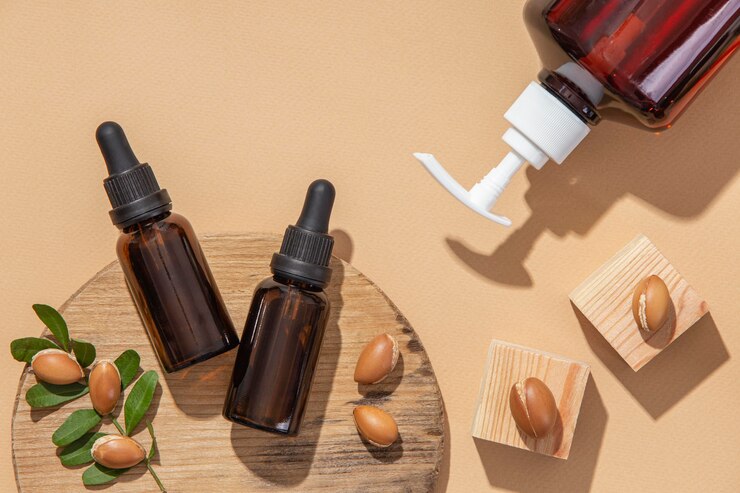More than just a beauty oil, food-grade argan oil is becoming a popular choice in health-conscious kitchens worldwide. Its nutty flavor and high nutritional value make it a true superfood that supports both well-being and tradition.
Let’s explore what makes this golden oil so powerful for your body and why it’s different from other culinary oils.
What Is Food-Grade Argan Oil?
Unlike cosmetic argan oil, food-grade argan oil is made by toasting the argan kernels before pressing. This gives the oil its rich taste and golden hue while keeping its nutrients intact. It is filtered and cold-pressed to ensure it’s safe and healthy to eat.
Key Characteristics
- Golden, toasted aroma and color
- Cold-pressed and unrefined
- High in omega-6 and omega-9 fatty acids
- Loaded with vitamin E and antioxidants
- 100% pure, natural, and safe for consumption
- Certified organic and sustainably sourced
📘 Health benefits of edible argan oil – WebMD

The Nutritional Power of Argan Oil
Heart Health Support
Thanks to its healthy fats, argan oil helps lower bad cholesterol while supporting good cholesterol, which contributes to a healthy heart.
Better Digestion and Immunity
With natural plant sterols and antioxidants, food-grade argan oil boosts the immune system and promotes smoother digestion.
Natural Anti-Inflammatory Benefits
Its anti-inflammatory properties make it useful for those dealing with chronic pain or inflammation-related health conditions.
Slows Aging from Within
Its richness in vitamin E and polyphenols helps fight free radicals and slows down the aging process.
How It Differs from Other Edible Oils
Most commercial cooking oils are processed and stripped of nutrients. In contrast, argan oil is handcrafted, minimally processed, and naturally rich in vitamins and fatty acids.
| Feature | Argan Oil | Olive Oil | Sunflower Oil |
|---|---|---|---|
| Cold-pressed | ✅ Always | Sometimes | Rare |
| High vitamin E | ✅ Yes | ⚠️ Moderate | ⚠️ Moderate |
| Rich in antioxidants | ✅ Yes | ✅ Yes | ❌ Low |
| Flavor profile | ✅ Nutty & deep | Neutral | Light |
| Traditional production | ✅ Yes | Sometimes | Rare |
How to Use Argan Oil in Your Meals
- Add a spoonful to salads or roasted veggies
- Mix into couscous, quinoa, or rice bowls
- Dip bread in it, Moroccan-style
- Blend into smoothies for added nutrition
- Use as a finish over grilled meats or fish
Price and Product Value
Food-grade argan oil is a premium product due to its traditional process and nutritional content. However, its long shelf life and small serving needs make it cost-effective.
- Toasted food-grade oil: $60–$85 per liter
- Organic and private-label options: On request
👉 Browse premium food-grade argan oil at argan-oil.ma
What Makes It So Unique?
Unlike many commercial oils, argan oil is:
- Produced by women’s cooperatives
- Grown in UNESCO-protected forests
- Made with zero synthetic additives
- Fully traceable and fair-trade certified
📘 Why sustainable oils matter – Fair Trade Certified

Customer Testimonials
“The flavor is amazing, and it’s great to know I’m supporting a women-run cooperative.” – Emily, Berlin
“I started using it in place of olive oil. Now it’s a must-have in my kitchen.” – Mohamed, Dubai
“Argan oil adds depth to my dishes, and the health benefits are a bonus.” – Laura, London
Blogger’s Personal Opinion
As a wellness and clean food blogger, I’ve tried dozens of oils, but nothing compares to the richness and integrity of Moroccan food-grade argan oil. Not only does it enhance my meals, but I also feel great knowing it empowers women and protects ancient traditions. That’s why I always recommend trusted sources like argan-oil.ma. Their products reflect quality, heritage, and care.
Conclusion
Food-grade argan oil is more than just a trendy kitchen product—it’s a powerful superfood, a sustainable choice, and a way to connect with Moroccan tradition. Whether you’re adding it to a salad or gifting it to a food lover, it’s a healthy decision with long-lasting value.
👉 To try the best Moroccan food-grade argan oil, visit argan-oil.ma today.

